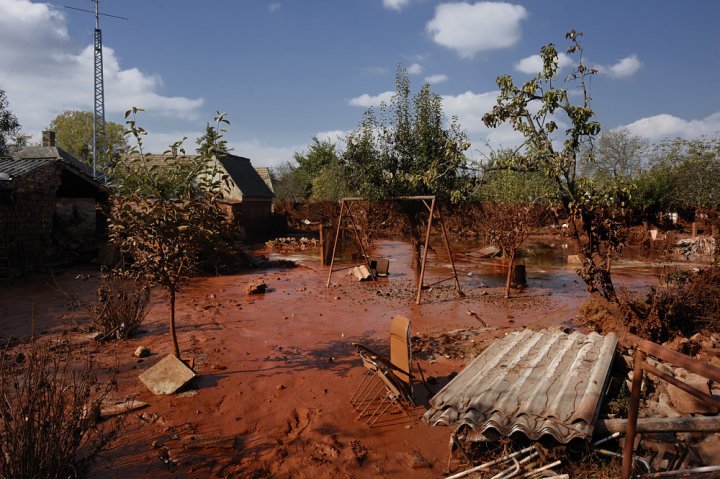 Slovenian bee colonies are in great danger, for they are again being killed in mass quantities due to extensive use of Phytopharmaceuticals in agriculture. There was a huge colony collapse in Slovenia already in 2011 due to insecticide called Clothianidin which belongs to the group of neonicotinoids. Neonicotinoids are insecticides that are chemically similar to nicotine, which has been used as a pesticide since the late 1700s and acts on central nervous system of an animal which results in its death.
Slovenian bee colonies are in great danger, for they are again being killed in mass quantities due to extensive use of Phytopharmaceuticals in agriculture. There was a huge colony collapse in Slovenia already in 2011 due to insecticide called Clothianidin which belongs to the group of neonicotinoids. Neonicotinoids are insecticides that are chemically similar to nicotine, which has been used as a pesticide since the late 1700s and acts on central nervous system of an animal which results in its death.
Despite a relatively stable number of bee colonies in Slovenia there is a loss of almost one third of all the bees that occurs every two years. In April this year when bee season is not even at its beginning, the beekeepers were already again facing huge losses of bee colonies. The veterinarian inspection service is actively investigating the situation in close collaboration with police, since there is a high suspicion that the local farmers might be using illegal pesticides to spray their crops.
The terrifying fact about Slovenian bee colony collapse is that the use of Phytopharmaceuticals that are suspected to be the cause of deaths is at this time of year prohibited for use and therefore the question remains if killing of the bees is in any way intentional?
At the Beekeeping Association of Slovenia they are convinced that this is as they say, a systematic problem and they blame not the farmers that use those Phytopharmaceuticals, but the companies that produce them. They say farmers don’t always know what exactly is in the products they buy. The fact is also that the concentration of the active ingredients in the Phytopharmaceuticals is the highest in spring and that could result in high risk for bees survival.
To know more about Bee colony collapse click here, to learn more about the effects of neonicotinoids on birds click here and of course to end ecocide click here!



7 commentaires
Bambier · Sunday 18 May 2014 à 20:26
Le Français semble banni pour l’article : Ecocide in Slovenia: Bee colony collapse.
Pourquoi ?
La Finance impose l’Anglais ?
Regards.
pauline · Sunday 18 May 2014 à 20:34
Bonjour,
Le français n’est pas « banni » nous manquons seulement de temps et de volontaires pour traduire l’intégralité des articles du blog – Cela dit nous serions très heureux de vous compter parmi nos traducteurs si vous le souhaitez !
Pauline pour End Ecocide
Kerstin Salen · Sunday 18 May 2014 à 21:21
GMO crops are designed to withstand the chemicals used to control both insects and weeds. GMO corn, as well as other crops, can be sprayed with neonicotinoid systemic pesticide and herbicides, allowing all other plants to be killed except the GMO crop being cultivated. Roundup Ready crops is the best known example.
Systemic pesticides are also applied to the seeds prior to planting. For some crops such as corn, soybean, and cotton, better than 90% of the seeds planted are coated with neonicotinoid system pesticides. While GMO and neonicotinoid applied systemic pesticides are two different issues, from an industry practical application, they are one and the same.
How does systemic pesticides work?
Systemic pesticides are absorbed into the plant as they grow, being soaked up into the root system. The pesticides are in the entire plant. So any pest eating on the leaves on the treated plant is killed. This is the intended purpose. But those same pesticides are also now in the pollen, which is being collected by the honey bees, beneficial pollinators, and other insects. Neonicotinoid and systemic treated seeds can easily be recognized as seeds with various colors such as purple, pink, green, and blue coatings.
Roundup is commonly used in industrialised agriculture and this might be the reason bees everywhere are affected.Of course the manufacturer, like in this case Monsanto, should be held responsible for the ecocide they are causing.Thank you and best wishes Kerstin
Peter · Saturday 14 June 2014 à 06:21
An excellent explanation Keratin. The big worry is all this chemicals end up in the foods we eat. No wonder human beings suffer from an increased number of illnesses which then have to be treated with drugs probably often made by the same offending companies. Peter
Henri weemaels · Monday 19 May 2014 à 07:37
Ola,
Cette extinction des abeilles est quasi générale. C’est dramatique bien sûr car toute la chaine de production alimentaire dépend de la polénisation.
Est ce seulement des insecticides qui sont la cause ?
Avez vous déjà entendu parler des chemtrails et de la maladie du morgellon ?
Renseignez vous, c’est là des phénomènes nouveaux et diablement inquiétant.
Pour le morgellon voici plus de 11 ans que mon épouse en souffre et je sais de quoi je parle. Les personnes qui en sont atteints ont des fibres qui sortent de la peau. Le lien avec les abeiles ? Des abeilles ont été retrouvés mortes le corps remplis de fibres … Bien à vous
Barbara Dickson · Wednesday 21 May 2014 à 19:44
These companies have a lot to answer for. Continuing to destroy the natural world is an offence against humanity – how to stop their destruction?
pauline · Thursday 29 May 2014 à 18:06
The Ecocide law seems like a good start, share it widely among your friends, colleagues and family! 🙂
If you want to help us, you can also become a volunteer at End Ecocide on Earth 🙂
contact : [email protected]